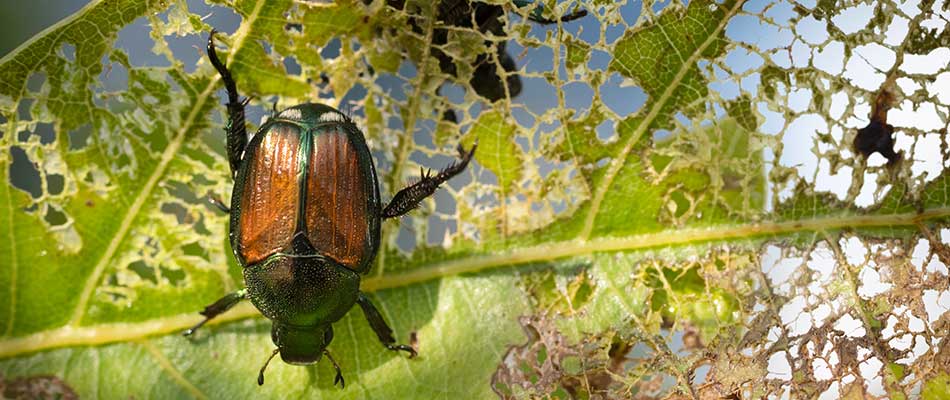japanese beetle life cycle iowa
Grub The eggs hatch within the next 8-14 days and tiny grubs emerge out. Japanese beetle life cycle.
Where Have All The Beetles Gone Homegrown Iowan
The adults mate and females lay their eggs in the soil in grassy areas.

. How to Recognize the Japanese Beetles Life Stages. Most of the beetles life is spent underground only emerging in the adult phase we all know and loathe. The female Japanese beetle life span is about 30-45 days during which she can lay about 40-60 eggs.
Physical Description and Identification Adult. The adult Japanese beetle is a little less than half an inch long and has a shiny metallic-green body with bronze-colored outer wings. Popillia japonica Other Characteristic Features.
50131 - Johnston Iowa. Stage 1 eggs Stage 2 larva instar I II III Stage 3 pupa chrysalis. About 12 inch long these eye-catching pests have shiny bronze.
The Japanese beetle has four stages in its life cycle two of which can be destructive to your lawn and garden. Grubs cease feeding in October and overwinter 15 cm below the soil surface Figure 3. In the spring around March or April the grub will.
The first signs usually appear when mature beetles emerge from the ground in late spring to midsummer often flying in from nearby areas and targeting stressed plants. Corn soybean ornamentals fruit trees grapes weeds. They overwinter deep in the soil and resurface again in spring when soil temperatures rise to feed for another 3 to 4 weeks before emerging as adult Japanese beetles.
Japanese beetle have one generation per year Figure 2. Adult female beetles lay eggs in the soil in early June. These eggs hatch late July into August and are small and close to the soil surface.
These beetles have a bright appearance due to their color combination a metallic green head and thorax and a copper-colored elytra partially covering their abdomen. These large groups can devastate the garden. Japanese beetles are often found in field edges or areas of delayed growth.
The adult Japanese beetle is a little less than half an inch long and has a shiny metallic-green body with bronze-colored. Shortly after the egg will hatch and give rise to grubs. Japanese beetles mainly feed on the leaves of their host plant skeletonizing them in a matter of days.
Once they emerge they will start eating. In the summer around June or July full-grown beetles will lay eggs. These beetles can feed on more than 300 plant.
Females lay eggs in soil that hatch within seven to 14 days and grubs begin feeding on grass roots. Japanese beetle damage is magnified because destruction occurs during multiple life stages. The Japanese beetle did not appear in Iowa until 1994 but is now found in over 34ths of the state.
In most parts of its range the Japanese beetle completes its life-cycle in one year but some populations in cooler climates may complete their development in two years Vittum 1986. The beetle has six small tufts of white hair along the sides and back of its body under the edges of its wings. Adults begin to emerge in May and feed on foliage through September.
Look the life cycle of the Japanese beetle is much like the cycle of many other beetles. JAPANESE BEETLE LIFE CYCLE. HOW TO PREVENT JAPANESE BEETLES.
Egg larvae and pupa. Life Cycle of the Japanese Beetle. Appearance of adult the timing of oviposition and subsequent development have been shown to vary with latitude altitude and also from year to year Fleming 1972.
Japanese beetles go through multiple stages in their life cycle. Life Cycle Japanese beetles have one generation per year in Iowa Fig. For more on plant selection see Japanese Beetle Food Preferences from Iowa State University.
The most susceptible life stage of the Japanese beetle is the newly hatched grub in the soil. Ad Enjoy low prices on earths biggest selection of books electronics home apparel more. The adult female will lay eggs in soil or near the base of plants.
These grubs will begin to eat the roots of plants and overwinter as a grub. Adult female beetles lay eggs in the soil in early June. Management of Japanese Beetle.
This is when they are easiest to control. The life cycle of Japanese beetles consists of three stages. Japanese beetles are similar to other Junebugs in appearance and 38 inch long and 14 inch wide.
The eggs hatch in about 2 weeks and the developing Japanese beetle larvae white grubs feed on organic matter and grass roots. The males usually are. Please enter a valid location.
A few weeks after hatching from the eggs small larvae begin to feed on grass roots then transform into pupae where they rest before emerging as adults. You can use an organic product called Milky Spore.

Is It Japanese Beetle In The Field Or Something Else Integrated Crop Management

Japanese Beetle Control In Des Moines West Des Moines Ankeny Ia A Lawn Landscape

The Japanese Beetle Has Reached Its Peak Population In Places Across Iowa While Some Areas Of The State Have Not Seen The Bee Japanese Beetles Beetle Japanese

Crop Insects To Watch For In June Iowa Agribusiness Network

Japanese Beetles The Garden Website Com

Doug S Garden Blog They Re Here Time To Protect Your Plants

Japanese Beetles Begin Emergence Integrated Crop Management

Japanese Beetles Emerging In Southern Iowa Integrated Crop Management

Japanese Beetle Control In Des Moines West Des Moines Ankeny Ia A Lawn Landscape

Japanese Beetles Expanding Range In Iowa Integrated Crop Management

How Many Japanese Beetles Will You See This Year Horticulture And Home Pest News

Japanese Beetle Adult Emergence Begins In Southern Iowa Integrated Crop Management

Japanese Beetle Food Preferences Horticulture And Home Pest News

Signs Of Japanese Beetle Infestations Shades Of Green Lawn Landscape
